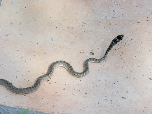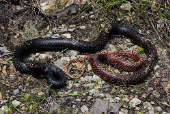Eastern Coachwhip (Masticophis flagellum flagellum)
Description: Adults are long and slender, ranging from 50 to 72 inches in total length. The longest on record was 102 inches. The head and neck are usually black, fading to tan posteriorly. Some specimens may lack the dark head and neck pigmentation. Their smooth scales and coloration give the appearance of a braided whip, hence the common name.
Habitat: The subspecies can be found in a wide variety of habitats, but is most abundant in the southeastern coastal plain. Its preferred habitat includes sandy pine woodlands, pine-palmetto flatwoods, cedar glades, and along creeks, marshes and swamplands. M. flagellum adults and juveniles can be found in suburban neighborhoods where development encroaches on favorable habitats. A study done in southwestern Georgia found that the average home-range for the coachwhip is around 102.9 ± 28 ha. As they are open canopy specialists, coachwhips are good at returning to habitats soon after fires.
Range: The subspecies ranges from North Carolina to Florida in the east, and from eastern Kansas to eastern Texas in the west. They are notably absent from the Mississippi Delta, which divides their range into two separate groupings.
Diet: Prey items include birds, large insects, lizards, other snakes, and small mammals. This snake has also been observed feeding on carrion.
Reproduction: The breeding seasons spans from June through August, in which females produce one clutch of 4-24 eggs with an average of 11. Males reach sexual maturity at age 1 whereas females don't attain sexual maturity until age 3. Courtship behavior from males instigates copulation with a female, which can last up to 130 min. Mating system is polyandrous, meaning that although females will only produce one clutch of eggs, they will mate with multiple males over the breeding period. Males have been observed displaying territorial behavior in an attempt to prevent any further copulation from other males. The gestation period is around 77.5 days after which the female lays the eggs in a small animals burrow, no parental care is shown.
Status: Listed as Least Concern in view of its extremely wide distribution, presumed large population, no major threats, and because its population is not currently in decline.
»» Kingdom: Animalia - Animals
»» Phylum: Chordata - Chordates
»» Subphylum: Vertebrata - Vertebrates
»» Class: Reptilia - Reptiles
»» Order: Squamata - Scaled Reptiles
»» Suborder: Serpentes
»» Superfamily: Colubroidea
»» Family: Colubridae - Colubrids
»» Genus: Masticophis
»» Species: Masticophis flagellum - Coachwhips
»» Subspecies: Masticophis flagellum flagellum - Eastern Coachwhip
This article uses material from the Wikipedia article "Masticophis flagellum flagellum", which is released under the Creative Commons Attribution-Share-Alike License 3.0. Content may have been omitted from the original, but no content has been changed or extended.
|








